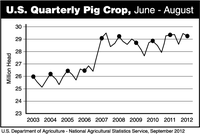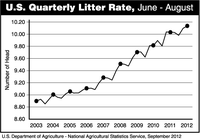Feed Costs Challenging for Pork Producers
(Click an image below to view a high-resolution image that can be downloaded)
This could be a challenging year for pork producers, according to David Newman, the North Dakota State University Extension Service’s swine specialist.
One major issue will be feed costs. A projected increase in pork production in 2013 means producers will need more feed at a time when drought continues to be a problem in major corn-producing states, a large portion of the U.S. corn crop is being exported or used to produce ethanol, and other feedstuffs may not be available in sufficient quantities or at reasonable prices, Newman says. Ultimately, the bigger demand for feed will drive up feed costs.
The demand for pork needs to increase at high levels domestically and globally to support this increased volume of pork being produced, Newman says. Also, he advises producers to continue to manage margins and use good production practices.
“Benchmarking performance, managing animal health, improving feed efficiency and focusing on good pig management are critical,” he says. “The current financial staying power among pork producers is a reflection of good business practices.”
Fewer sows producing larger number of pigs per litter in the U.S. is one example of good pig management, according to Newman. The national average from June to August 2012 was a little more than 10 pigs per litter, compared with an average of a little less than nine pigs per litter a decade ago.
“Good management also is responsible for the recent increase in 2013 pork production estimates by the U.S. Department of Agriculture as the number of sows planned to farrow in the first half of 2013 is down 1 percent,” Newman says.
To help offset the high production numbers and reduce feed costs, corn-producing regions need sufficient rainfall this spring and summer, he contends.
“The likelihood that record acres of corn will be planted is high, so a good growing season could help change the corn supply and drive down feed costs,” he says.
NDSU Agriculture Communication - Jan. 18, 2013
| Source: | David Newman, (701) 231-7366, david.newman@ndsu.edu |
|---|---|
| Editor: | Ellen Crawford, (701) 231-5391, ellen.crawford@ndsu.edu |




